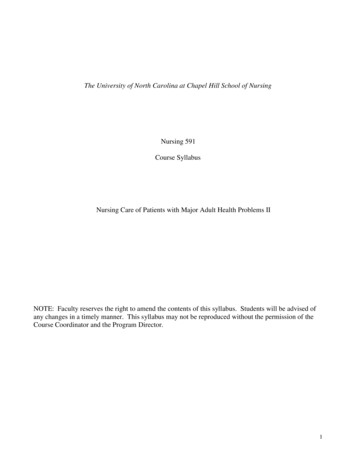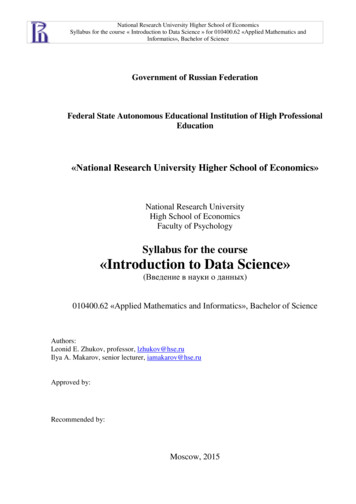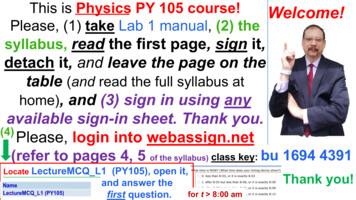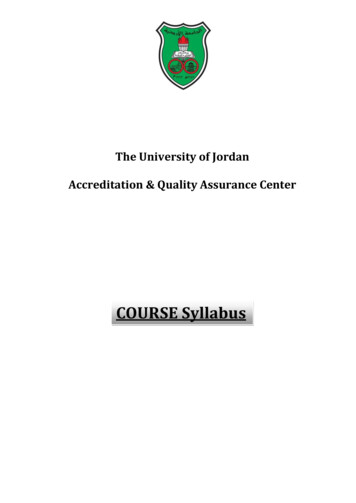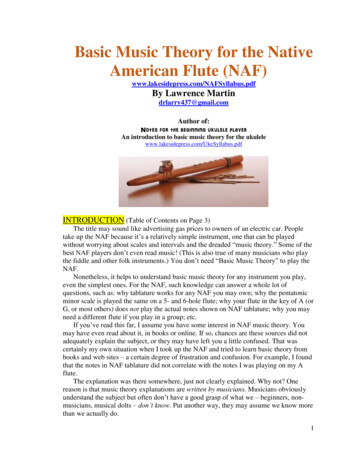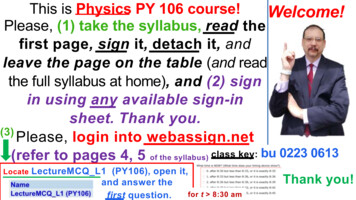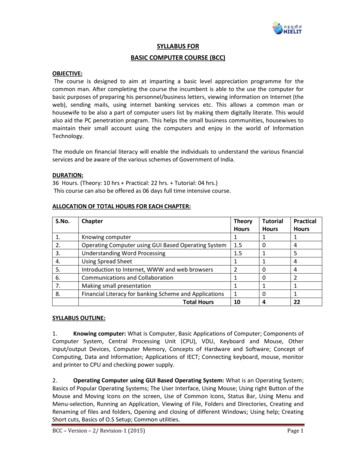
Transcription
SYLLABUS FORBASIC COMPUTER COURSE (BCC)OBJECTIVE:The course is designed to aim at imparting a basic level appreciation programme for thecommon man. After completing the course the incumbent is able to the use the computer forbasic purposes of preparing his personnel/business letters, viewing information on Internet (theweb), sending mails, using internet banking services etc. This allows a common man orhousewife to be also a part of computer users list by making them digitally literate. This wouldalso aid the PC penetration program. This helps the small business communities, housewives tomaintain their small account using the computers and enjoy in the world of InformationTechnology.The module on financial literacy will enable the individuals to understand the various financialservices and be aware of the various schemes of Government of India.DURATION:36 Hours. (Theory: 10 hrs Practical: 22 hrs. Tutorial: 04 hrs.)This course can also be offered as 06 days full time intensive course.ALLOCATION OF TOTAL HOURS FOR EACH CHAPTER:S.No.Chapter1.2.3.4.5.6.7.8.Knowing computerOperating Computer using GUI Based Operating SystemUnderstanding Word ProcessingUsing Spread SheetIntroduction to Internet, WWW and web browsersCommunications and CollaborationMaking small presentationFinancial Literacy for banking Scheme and ApplicationsTotal 04PracticalHours1454421122SYLLABUS OUTLINE:1.Knowing computer: What is Computer, Basic Applications of Computer; Components ofComputer System, Central Processing Unit (CPU), VDU, Keyboard and Mouse, Otherinput/output Devices, Computer Memory, Concepts of Hardware and Software; Concept ofComputing, Data and Information; Applications of IECT; Connecting keyboard, mouse, monitorand printer to CPU and checking power supply.2.Operating Computer using GUI Based Operating System: What is an Operating System;Basics of Popular Operating Systems; The User Interface, Using Mouse; Using right Button of theMouse and Moving Icons on the screen, Use of Common Icons, Status Bar, Using Menu andMenu-selection, Running an Application, Viewing of File, Folders and Directories, Creating andRenaming of files and folders, Opening and closing of different Windows; Using help; CreatingShort cuts, Basics of O.S Setup; Common utilities.BCC – Version – 2/ Revision-1 (2015)Page 1
3.Understanding Word Processing: Word Processing Basics; Opening and Closing ofdocuments; Text creation and Manipulation; Formatting of text; Table handling; Spell check,language setting and thesaurus; Printing of word document.4.Using Spread Sheet: Basics of Spreadsheet; Manipulation of cells; Formulas andFunctions; Editing of Spread Sheet, printing of Spread Sheet.5.Introduction to Internet, WWW and Web Browsers: Basic of Computer networks; LAN,WAN; Concept of Internet; Applications of Internet; connecting to internet; What is ISP;Knowing the Internet; Basics of internet connectivity related troubleshooting, World Wide Web;Web Browsing softwares, Search Engines; Understanding URL; Domain name; IP Address; Usinge-governance website6.Communications and collaboration: Basics of electronic mail; Getting an email account;Sending and receiving emails; Accessing sent emails; Using Emails; Document collaboration;Instant Messaging; Netiquettes.7.Making Small Presentation: Basics of presentation software; Creating Presentation;Preparation and Presentation of Slides; Slide Show; Taking printouts of presentation / handouts.8.Financial Literacy for Banking Scheme and Applications: Why savings are needed, Whysave in a bank, Banking products-ATM card, Banking Instruments-Cheque, Demand Draft (DD),Banking Services Delivery Channels, Know Your Customer (KYC), Opening of bank account anddocuments required, Types of bank accounts, Bank’s services including remittances, loan,mobile banking, Overdraft, Pension etc., Pradhan Mantri Jan Dhan Yojana (PMJDY), passwordsecurity and ATM withdrawal, Insurance, Social Security Schemes-Atal Pension Yojana (APY),Pradhan Mantri Suraksha Bima Yojana (PMSBY), Pradhan Mantri Jeevan Jyoti Bima Yojana(PMJJBY), Pradhan Mantri Mudra Yojana (PMMY).BCC – Version – 2/ Revision-1 (2015)Page 2
DETAILED SYLLABUS1. KNOWING COMPUTER1.0 Introduction1.1 Objectives1.2 What is Computer?1.2.1 Basic Applications of Computer1.3 Components of Computer System1.3.1 Central Processing Unit1.3.2 Keyboard, mouse and VDU1.3.3 Other Input devices1.3.4 Other Output devices1.3.5 Computer Memory1.4 Concept of Hardware and Software1.4.1 Hardware1.4.2 Software1.4.2.1 Application Software1.4.2.2 Systems software1.5 Concept of computing, data and information1.6 Applications of IECT1.6.1 e-governance1.6.2 Entertainment1.7 Bringing computer to life1.7.1 Connecting keyboard, mouse, monitor and printer to CPU1.7.2 Checking power supply1.8 Summary1.9 Model Answers2. OPERATING COMPUTER USING GUI BASED OPERATING cs of Operating System2.2.1Operating system2.2.2Basics of popular operating system (LINUX, WINDOWS)The User Interface2.3.1Task Bar2.3.2Icons2.3.3Menu2.3.4Running an ApplicationOperating System Simple Setting2.4.1Changing System Date And Time2.4.2Changing Display Properties2.4.3To Add Or Remove A Windows Component2.4.4Changing Mouse Properties2.4.5Adding and removing PrintersFile and Directory Management2.5.1Creating and renaming of files and directoriesBCC – Version – 2/ Revision-1 (2015)Page 3
2.62.72.8Common utilitiesSummaryModel Answers3. UNDERSTANDING WORD bjectivesWord Processing Basics3.2.1Opening Word Processing Package3.2.2Menu Bar3.2.3Using The Help3.2.4Using The Icons Below Menu BarOpening and closing Documents3.3.1Opening Documents3.3.2Save and Save as3.3.3Page Setup3.3.4Print Preview3.3.5Printing of DocumentsText Creation and manipulation3.4.1Document Creation3.4.2Editing Text3.4.3Text Selection3.4.4Cut, Copy and Paste3.4.5Spell check3.4.6ThesaurusFormatting the Text3.5.1Font and Size selection3.5.2Alignment of Text3.5.3Paragraph Indenting3.5.4Bullets and Numbering3.5.5Changing caseTable Manipulation3.6.1Draw Table3.6.2Changing cell width and height3.6.3Alignment of Text in cell3.6.4Delete / Insertion of row and column3.6.5Border and shadingSummaryModel Answers4. USING SPREAD SHEET4.04.14.2IntroductionObjectivesElements of Electronic Spread Sheet4.2.1Opening of Spread Sheet4.2.2Addressing of CellsBCC – Version – 2/ Revision-1 (2015)Page 4
4.34.44.54.64.2.3Printing of Spread Sheet4.2.4Saving WorkbooksManipulation of Cells4.3.1Entering Text, Numbers and Dates4.3.2Creating Text, Number and Date Series4.3.3Editing Worksheet Data4.3.4Inserting and Deleting Rows, Column4.3.5Changing Cell Height and WidthFormulas and Function4.4.1Using Formulas4.4.2FunctionSummaryModel Answers5. INTRODUCTION TO INTERNET, WWW AND WEB tionObjectivesBasic of Computer Networks5.2.1 Local Area Network (LAN)5.2.2 Wide Area Network (WAN)Internet5.3.1 Concept of Internet5.3.2 Applications of Internet5.3.3 Connecting to the Internet5.3.4 TroubleshootingWorld Wide Web (WWW)Web Browsing Softwares5.5.1 Popular Web Browsing SoftwaresSearch Engines5.6.1 Popular Search Engines / Search for content5.6.2 Accessing Web Browser5.6.3 Using Favorites Folder5.6.4 Downloading Web Pages5.6.5 Printing Web PagesUnderstanding URLSurfing the web5.8.1 Using e-governance websiteSummaryModel Answers6. COMMUNICATIONS AND COLLABORATION6.06.16.2IntroductionObjectivesBasics of E-mail6.2.1 What is an Electronic Mail6.2.2 Email AddressingBCC – Version – 2/ Revision-1 (2015)Page 5
6.36.46.56.66.7Using E-mails6.3.1 Opening Email account6.3.2 Mailbox: Inbox and Outbox6.3.3 Creating and Sending a new E-mail6.3.4 Replying to an E-mail message6.3.5 Forwarding an E-mail message6.3.6 Sorting and Searching emailsDocument collaborationInstant Messaging and Collaboration6.5.1 Using Instant messaging6.5.2 Instant messaging providers6.5.3 NetiquettesSummaryModel Answers7. MAKING SMALL nObjectivesBasics7.2.1 Using PowerPoint7.2.2 Opening A PowerPoint Presentation7.2.3 Saving A PresentationCreation of Presentation7.3.1Creating a Presentation Using a Template7.3.2Creating a Blank Presentation7.3.3Entering and Editing Text7.3.4Inserting And Deleting Slides in a PresentationPreparation of Slides7.4.1 Inserting Word Table or An Excel Worksheet7.4.2 Adding Clip Art Pictures7.4.3 Inserting Other Objects7.4.4 Resizing and Scaling an ObjectPresentation of Slides7.5.1 Viewing A Presentation7.5.2 Choosing a Set Up for Presentation7.5.3 Printing Slides And HandoutsSlide Show7.6.1 Running a Slide Show7.6.2 Transition and Slide Timings7.6.3 Automating a Slide ShowSummaryModel Answers8. FINANCIAL LITERACY FOR BANKING SCHEME AND APPLICATIONS8.0IntroductionBCC – Version – 2/ Revision-1 (2015)Page 6
8.18.2ObjectivesWhy Savings are needed?8.2.1 Emergencies8.2.2 Future Needs8.2.3 Large expenses8.3 Drawbacks of keeping Cash at home8.3.1 Unsafe8.3.2 Loss of Growth Opportunity8.3.3 No Credit Eligibility8.4 Why Bank is needed?8.4.1 Secure Money, Earn Interest, Get Loan8.4.2 Inculcate habit of saving8.4.3 Remittances using Cheque Demand Draft8.4.4 Avoid risk of chit funds, sahukars8.4.5 Documents needed for opening a bank account8.5 Banking Products8.5.1 Types of Accounts and Deposit8.5.2 Types of Loan and Overdrafts8.5.3 Filling up of Cheques, Demand Drafts8.6 Banking Service Delivery Channels - I8.6.1 Bank Branch, ATM8.6.2 Bank Mitra with Micro ATM8.7 Banking Service Delivery Channels - II8.7.1 Internet Banking8.7.2 National Electronic Fund Transfer (NEFT), Real Time Gross Settlement (RTGS)8.8 Various Schemes8.8.1 Pradhan Mantri Jan-Dhan Yojana (PMJDY)8.8.2 Social Security Schemes8.8.2.1 Pradhan Mantri Suraksha Bima Yojana (PMSBY)8.8.2.2 Pradhan Mantri Jeevan Jyoti Bima Yojana (PMJJBY)8.8.2.3 Atal Pension Yojana (APY)8.8.2.4 Pradhan Mantri Mudra Yojana (PMMY)8.8.3 National Pension Scheme8.8.4 Public Provident Fund (PPF) Scheme8.9 Bank on your mobile8.9.1Mobile Banking8.9.2Mobile Wallets8.10 Insurance8.10.1 Necessity of Insurance8.10.2 Life Insurance and Non-life Insurance8.11 Summary8.12 Model Answers--xxx--BCC – Version – 2/ Revision-1 (2015)Page 7
BASIC COMPUTER COURSE (BCC) OBJECTIVE: The course is designed to aim at imparting a basic level appreciation programme for the common man. After completing the course the incumbent is able to the use the computer for basic purposes of preparing his personnel/business letters, viewing in
